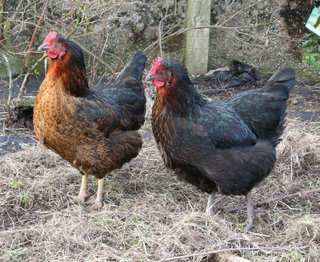
Why Bother?
We wanted to know exactly where our eggs came from and that the chickens were well cared for, free range and not killed as soon as they stopped laying.
Which Breed?
I did a bit of research about different chicken breeds on the Internet and came across Kintaline Farm’s article about Black Rock hens. They are a cross between superior quality Rhode Island Reds and Barred Plymouth Rocks.
They are described as: -
· hardy – taking wind, rain, snow or heat in their stride
· disease resistant
· long-lived and good layers
· characterful, yet docile and simple to keep
· of attractive appearance, black feathered with a green shimmer and chestnut feathers at the neck
In fact, they sounded ideal for our elevated (and sometimes wet and windy) garden.
The Black Rocks are a hybrid exclusively bred and hatched by Mr Siddons of the Muirfield Hatchery in the East of Scotland. They are sold through a network of intermediaries and I was able to find someone who would deliver a single pair to our door. [Beware that some people offer similar looking chickens for sale as ‘Black Rocks’: it is best to check with Mr Siddons that they are genuine.]
Naming
Before ‘the girls’ arrived we spent a night poring over a ‘1,000 Baby Names’ book. Henrietta, Brunhilda, Gretel, Anna and Hilda were all considered and rejected. We plumped for Cleopatra and Clarissa.
Eglu
We drew up plans for an arc, and then a run that would fit over our raised beds, and then we saw an advert for Eglus. The cheapest runs we had seen for sale had been over a hundred pounds delivered. Although the Eglus were more than double that, we loved the design of them and they are fox and badger proof. An Eglu seemed the ideal size for the two medium-sized chickens we wanted. We ordered one and it turned up at the end of June 2005. After half an hour or so struggling with the irritating little clips that hold the four run sections together, we had it up and ready for habitation.
The Eglu is cleaned and moved once a week and has been very easy to care for. We give the girls plenty of clean straw to snuggle down in to; they weren’t very keen on the shredded newspaper we tried to begin with.
The only weak points of the set up are the plastic screws that fix the run to the hutch, but the nice people at Omlet have sent me replacement ones free of charge on the two occasions that we’ve needed them. We hold the run down with tent pegs for extra security. In the winter we throw an old duvet and a waterproof cover over the hutch for added warmth and draft-proofing and we always have the shade over one side and the top of the run blocking any wind, rain or hot sun. We felt that the roosting bars inside were too narrow so replaced them with some wider ones.
I have to say that the hens rarely choose to go into the run and hutch during the day – just for egg laying and sleeping. If they want to shelter from the rain during the day, they go into the greenhouse or polytunnel. They can be enticed back into it quite easily with some food, however.
We wanted to know exactly where our eggs came from and that the chickens were well cared for, free range and not killed as soon as they stopped laying.
Which Breed?
I did a bit of research about different chicken breeds on the Internet and came across Kintaline Farm’s article about Black Rock hens. They are a cross between superior quality Rhode Island Reds and Barred Plymouth Rocks.
They are described as: -
· hardy – taking wind, rain, snow or heat in their stride
· disease resistant
· long-lived and good layers
· characterful, yet docile and simple to keep
· of attractive appearance, black feathered with a green shimmer and chestnut feathers at the neck
In fact, they sounded ideal for our elevated (and sometimes wet and windy) garden.
The Black Rocks are a hybrid exclusively bred and hatched by Mr Siddons of the Muirfield Hatchery in the East of Scotland. They are sold through a network of intermediaries and I was able to find someone who would deliver a single pair to our door. [Beware that some people offer similar looking chickens for sale as ‘Black Rocks’: it is best to check with Mr Siddons that they are genuine.]
Naming
Before ‘the girls’ arrived we spent a night poring over a ‘1,000 Baby Names’ book. Henrietta, Brunhilda, Gretel, Anna and Hilda were all considered and rejected. We plumped for Cleopatra and Clarissa.
Eglu
We drew up plans for an arc, and then a run that would fit over our raised beds, and then we saw an advert for Eglus. The cheapest runs we had seen for sale had been over a hundred pounds delivered. Although the Eglus were more than double that, we loved the design of them and they are fox and badger proof. An Eglu seemed the ideal size for the two medium-sized chickens we wanted. We ordered one and it turned up at the end of June 2005. After half an hour or so struggling with the irritating little clips that hold the four run sections together, we had it up and ready for habitation.
The Eglu is cleaned and moved once a week and has been very easy to care for. We give the girls plenty of clean straw to snuggle down in to; they weren’t very keen on the shredded newspaper we tried to begin with.
The only weak points of the set up are the plastic screws that fix the run to the hutch, but the nice people at Omlet have sent me replacement ones free of charge on the two occasions that we’ve needed them. We hold the run down with tent pegs for extra security. In the winter we throw an old duvet and a waterproof cover over the hutch for added warmth and draft-proofing and we always have the shade over one side and the top of the run blocking any wind, rain or hot sun. We felt that the roosting bars inside were too narrow so replaced them with some wider ones.
I have to say that the hens rarely choose to go into the run and hutch during the day – just for egg laying and sleeping. If they want to shelter from the rain during the day, they go into the greenhouse or polytunnel. They can be enticed back into it quite easily with some food, however.
Arrival
A delightful gentleman called Mr Eddie Lovett turned up a week later on a hot day in July with a truckload of hens. He opened the ‘Black Rock’ crate and fished out a beautiful, although slightly travel-worn bird, which he passed to me. I heard a flapping and commotion behind me and Rob later told me that a second chicken shot out of the crate so determinedly that there was no question of not picking her. We often wondered whether it was chance, or whether they were best friends and she couldn’t bear to be parted from her companion.
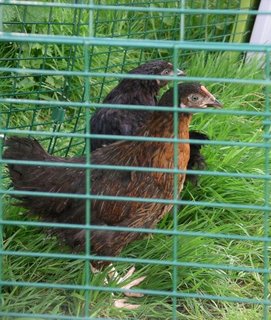
After tempting them with red worms from the compost heap, the girls soon became quite tame and would take them from our fingers. They were an odd pair, one with the promised black/green feathers, the other with brownish feathers. The former suited the name Cleopatra, but Clarissa just wasn’t right for the other. She seemed like a little bustling maidservant following her lady everywhere, so we called her Mabel. The girls were quite young at just 12 weeks and looked more like a crow and a young pheasant then a pair of hens.
Articles recommend keeping chickens shut in a run for a few days to make sure they realise that this is their new home. After that, we let them out into the garden to explore. The garden is about a third of an acre with some grass, shrubs, fruit trees and bushes, raised vegetable beds, lots of ‘wildlife’ (ie weedy and overgrown) areas and has a wall round it. We didn’t clip the chickens’ wings. Although Cleo jumped onto the wall sometimes when she was younger, she has never (to our knowledge) left the garden.
Articles recommend keeping chickens shut in a run for a few days to make sure they realise that this is their new home. After that, we let them out into the garden to explore. The garden is about a third of an acre with some grass, shrubs, fruit trees and bushes, raised vegetable beds, lots of ‘wildlife’ (ie weedy and overgrown) areas and has a wall round it. We didn’t clip the chickens’ wings. Although Cleo jumped onto the wall sometimes when she was younger, she has never (to our knowledge) left the garden.

We used to hold a daily ‘Chicken Parade’, which consisted of us carrying a chicken a piece round the garden to get them used to being handled. They don’t much like being picked up and one or other of us would usually end up with a chicken on our head, precursored by a lot of flapping and struggling (on the chicken’s behalf). We ceased this practice, but still pick them up from time to time to check for parasites (none yet) and general good health.
Cleo has a useful crouching reflex (ready for mating with the cockerel), which means that she can be caught quite easily. Mabel decided to ‘pass’ on this useful trait and it would be easier to catch a pickled onion with a blunt fork. If we need to look at her close-up, we wait until the morning, when she can be calmly scooped out of the Eglu via the egg hatch.
Character
Cleo started out being the brave, confident and vocal one and Mabel, with her occasional deep, rough cawing, followed her everywhere. Over time, Mabel has shown herself to be the forward and greedy one. She will even sit on my husband’s spade as he turns some turf over for them. (They call him ‘Worm Boy’.)
 They are surprisingly territorial and will chase adult pheasants out of the garden, but they did allow a neighbour’s peacock to put on a show for them once. They were unimpressed however, especially after he fell into the pond. He left humiliated, with his beautiful tail trailing sadly behind him.
They are surprisingly territorial and will chase adult pheasants out of the garden, but they did allow a neighbour’s peacock to put on a show for them once. They were unimpressed however, especially after he fell into the pond. He left humiliated, with his beautiful tail trailing sadly behind him.The chickens are both very inquisitive and must have acute hearing. Within a few minutes of starting any job in the garden, you will hear a distant ‘bar bar baarp’ noise getting louder and louder as they come over to investigate. They always supervise our gardening jobs, outdoor relaxation, and hutch cleaning duties. When we had the sorry task of digging a grave for our recently deceased dog, they lightened the mood a bit by coming and scratching the soil back into the hole as fast as we were shovelling it out.
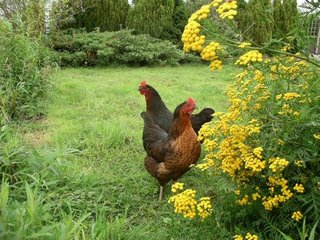
Cleo was a bit too nosey (beaky) when I was painting our lounge window. She jumped onto the window ledge and stuck her head in at the open window getting a collar of white gloss paint for her trouble. Having used a cloth to wipe off as much as possible, we didn’t dare to use any sort of chemical on her feathers and she still has a few specks of it visible to this day.
The two chicks are rarely apart, but if they become separated during the day (after one has been laying an egg, for example), the other one will caterwaul as loudly as possible to let her colleague know where she is. The first time it happened, we rushed outside thinking that a fox had nabbed them.
Feeding
We feed them on the organic layers’ pellets from Omlet, with some mixed grains and seeds (especially shelled sunflower seeds) for an afternoon treat.
They find their favourite food by scratching for worms, spiders and insects. The process involves a ‘forward and back and bow’ dance performance. They stand bolt upright to scratch a couple of times with their huge, scaly feet, then quickly take a step backwards and bow, cocking their heads to see if they have worried anything into the open. Any scurrying woodlouse or wriggling worm is quickly and accurately targeted before they return to Step One. Being vegetarian, we try not to think of the things that go into making our eggs – Mmmm! Worm eggs!
The plague of crane flies that we suffer every summer has been partly alleviated by chicken predation. You can hold Cleo and point her like a lethal weapon at a crane fly on the wall and within seconds it has been neatly folded like an umbrella and sucked down. (Mmmm! Crane fly eggs.)
They help themselves to growing greens of all types, from grass and weeds to lettuce, turnip tops, kale and other leafy greens such as mitzuna, sorrel, spinach and chard. They are not very keen on our leftover greens, probably because they are not as fresh, but also harder to pluck beakfuls from, even when tied in a bunch in the run as I have often seen recommended.
One evening we noticed that Mabel had a cricket ball sized ‘growth’ on one side of her chest. We started to panic until we read that it was just a wad of food in her crop and we recalled her stuffing down great sheets of chard leaves earlier in the day. We waited until the morning and it had completely disappeared.
We were amazed this summer, after a long spell of hot, dry, wormless weather, to find the girls wading in the shallow area of our tiny frog pond catching tadpoles. Once they had learnt to do it, they were in there every day, no doubt decimating our frog population, while keeping cool at the same time. (Mmmm! Tadpole eggs!) They are not averse to catching adult frogs either. On several occasions I have seen one of them with a limp amphibian in its beak being hotly pursued by the other, trying to snatch this tasty prize. You can really see their reptilian ancestry at times like that. (Mmmm! No, don’t even think about it.)
As long as the food is unsalted, the chickens enjoy cooked pasta and rice and various other leftovers such as cooked veg or pulses. If they hear one of us in the kitchen, they will stand outside the open window and squawk until they receive a suitable offering. They have us very well trained.

They drink a lot and need fresh drinking water daily in their run and they help themselves from anywhere else they can find it as well: they seem particularly keen on harvesting the fresh rain drops suspended from any surface, such as the garden furniture.
As they are free range, the girls get all the grit they need for their diet from the garden. If hens are caged, however, they need a separate supply of clean grit to help themselves to.
Dust Bath/Sunbathing
This hyperactive pair rarely spend much time at any one activity, and as I look out of the window of my office/workroom, I see them lap the house many times a day. One of their favourite pastimes is sunbathing. In warm, dry weather, they can often be found lying in a sunny spot, on one side with a wing and leg outstretched.
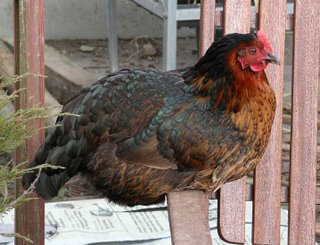
A favourite perch is our bench, which is in a sunny, sheltered spot behind the greenhouse. I would never recommend keeping chickens in a completely shady, damp corner of the garden, as they love the sun – although they do need some good shade when it’s very hot.
Another daily activity is having a dust bath. They search out the dusty, weed-free soil under the evergreen shrubs, or the empty beds in the polytunnel during the autumn and winter. They peck to loosen an area of soil before doing shoulder rolls and flapping the dust all over them. They almost seem to be hypnotised during this process and it is impossible to lure or tempt them back to their run. Everything has to stop for the dust bath. They sit there and relax, covered in dust, like ladies having a spa treatment, before standing up and flapping clouds of dust everywhere.
Shift System
When we first got the chicks, we had two dogs (now sadly, just one) and operate a shift system. Henry gets a couple of hours first thing in the morning, while the girls are confined to their run with only their dull layers’ pellets to eat. Then the dog gets his walk elsewhere and the chickens are let out into the garden. They go in again for a couple of hours at four o’clock so that Henry can have his afternoon ball chasing session. If it’s the summer they may get another spell out of the run before it gets dark, when they automatically turn in for the night. At other times, Henry goes out on the lead if he wants or needs to. (Good job we both work from home…)
Dogs and Chickens
The reason that we don’t let Henry out with the chickens is that we had an ‘unfortunate incident’. I had read on a couple of websites that hens will give troublesome dogs or cats a ‘peck on the nose’ and send them on their way, and that they should get on fine. Knowing Tess’ (our Staffordshire Bull Terrier’s) murderous feelings towards small furry or feathered creatures, we never risked her being off the lead with them. But we thought that Henry (only half Staffordshire) might learn to live with them.
We spent six months introducing them to each other, with Henry safely on the lead until we thought they knew each other well enough. We held our breath the first time he was allowed off the lead, but all seemed well. They would muddle about together and he mostly ignored them. We became quite casual about it after a month or so, and didn’t supervise at all times, until one day when we heard a terrible squawking coming from the hutch. Henry had bearded Mabel in her lair as she was sitting laying an egg. He had a firm grasp of her thigh and it was a scary minute as we pried them apart. He was left with a mouthful of feathers. Mabel retreated under a bush and went into shock. We checked her leg and as there was no broken skin or bones, thought it best to just leave her to recover. But after quickly reading up about shock in humans, I thought better of it and we took her into the warmth and safety of the greenhouse: allowing ‘the patient’ to get cold can be fatal, apparently.
It was warm, but not hot (I think it was autumn – in summer it would have been baking hot) in the greenhouse. We brought the hutch part of the Eglu in, along with Cleo and their food and drink. Over the next hours and days, we monitored Mabel’s condition closely. She was very subdued for a few days, hardly seeming to eat or drink, only waking up when one of us, or Cleo disturbed her. We bought her undyed maggots from the local fishing shop and these seemed to rally her, and within a week she was back to her old self. And that is why we operate the ‘shift system’. The moral of this story is don’t believe everything you read on the internet – you know your (and we should have known our) pet’s proclivities best, so trust your instincts.
Destructive Tendencies
We had quite a nice raised vegetable garden until we got the chickens… You would not believe the amount of scratching, potato unearthing, transplant uprooting and salad-leaf-eating that two medium-sized hens can carry out. Next year, we will be fencing off the vegetable plot.
They also produce a great number and volume of droppings – great for the compost heap – not so great on the patio or doorstep.
Eggs
The main reason we bought the chicks was for the lovely, fresh, free-range eggs. After several months and no eggs, we thought that something was up. Chickens can lay from around 18 weeks of age. One day, I noticed that some droppings had what looked like an egg yolk with them. I went back to the books and realised that this was a shell-less egg and that we needed to give them some calcium. I had wrongly assumed that this was part of the layers’ pellets. We bought a bag of oyster shell grit from the local pet shop, added it to the pellets and within days I found our first egg. It was so perfect that I could hardly bear to eat it, but I took a few photos and then fried it up. It tasted fantastic – so different to the shop bought eggs in yolk colour (much yellower) and consistency (much firmer yolk and white).

After that, the chickens didn’t look back and we were getting one or two eggs a day right through the autumn and winter.
During the hot days of summer, they took to laying the eggs in the strawberry bed, or an old half-barrel planted with flowers, or in a nettle patch rather than in the Eglu. It became a game, with them finding a new hiding place and us having to play ‘hunt the clutch’.
Egg production ceased completely a few weeks ago and I noticed that Mabel was getting a bit scruffy looking. Very unusual, since their plumage is normally immaculate (except for Cleo’s bottom, which she can’t reach for preening as she is so big. We give her an occasional trim to keep things hygienic.) They were just going into their first moult.
Moulting
They are about 18 months old, if my calculations are correct, and seem to have chosen the wettest and coldest part of the year to lose their feathers. It happens in stages with a bald neck one day and no fluffy bottom the next. Actually, it can take 2 – 3 months to replace the whole plumage. They were both miserable and lifeless for the first week or so and didn’t seem to eat as much as usual. Our neighbour reassured us that pheasants are exactly the same when they are moulting. They are now getting back to their usual mischievous and demanding selves, I’m glad to say. And we are looking forward to egg production resuming.
Range
I wish that I could fit a pedometer to Cleo and Mabel, as they must cover miles each day in their circuits of the garden. It’s not only the distance they cover that is surprising, but the variety of environments they choose at different times, depending on the weather and their current activity.
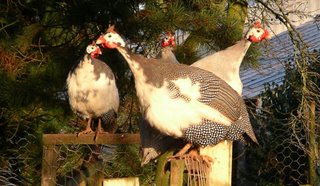
Our ex-neighbours’ assorted fowl (chickens, bantams, guinea fowl, peacocks, geese) would range even further without walls to deter them, and could often be seen several fields away from their home base.
The obvious question is, what sort of a life can any barn or battery farm raised chicken have? Until you keep chickens, you don’t realise what individual characters they are and what varied and active lives they lead.
Predators and Other Dangers
The main danger for our chickens (apart from Henry) are foxes, which I have seen running just the other side of our wall, even during daylight hours. I think that the presence of a dog and humans within the garden walls encourages them to stay outside, but it is an ever-present worry.
Our neighbours lost some birds to foxes, and some to speeding traffic on the small, unlisted road that runs by the houses. Other poultry keepers living near a small river had theirs killed by a mink. Another neighbour’s mother had her beautiful pet hens of nine years killed by a border collie that got into her garden. The lady in our local pet shop had a whole flock of prized, purebred chickens stolen from her garden. The horror stories seem endless!
The weasels, stoats and domestic cat that we have seen in the garden have not (so far) tried their luck.
We always make sure that our two are shut in the run before it’s dark and Rob ‘marks’ our boundaries in the traditional manner, as that is said to deter foxes.
Summary
Chickens make wonderful, entertaining pets and don’t take too much of your time each day (unless you want them to): letting out, feeding and watering at dawn (and checking for eggs), and shutting away at dusk. The accommodation/run needs cleaning once a week, and you need to make arrangements with a willing stand-in if you are away. Apart from the cost of the house and run, their food is cheap to buy and you get regular fresh, tasty eggs. We are even thinking about getting two more little friends to add to our brood in the spring. Four chickens can’t be any more trouble than two, can they?

Text and Photographs © J K Walton 2006
5 comments:
Hello: I saw your Flowers In A Vase on the front page of Etsy, then went to look at your other items.
I was so intriqued by your chicken needlework, that had already sold on Etsy, that I went to read your blog about your chickens.
Your Cleo and Mabel are very great ladies. I grew up on the farm and I treaure country life.
We had a biddie(baby chick) here in the city a few years ago; we used to let her out into the front yard daily for fresh air, and one day, the neighbors dog killed her. She was so pet and so sweet.
Your photos and your story is so great. Now, I realize that I must get back into gardening, rabbits (we used to have rabbits in the city, also) and chicken again.
Thanks for the inspiring story. By the way, your work is lovely.
Edna. I'm QuiltSalad on the Etsy site.
Thanks for your interesting comment, Edna.
I know what you mean about needing a little bit of the countryside, even when you are living in a city. I've been there myself!
Julia
I loved reading about Cleo and Mabel, Julia! :) They sound like wonderful additions to the family! :D
Thank you, Kylie! We do love our girls - they are now about five years old and look quite different to the photos - just as mischievous and demanding, though! ;)
So glad I found your blog and this wonderful story of two very impressive and beautiful girls!!
thanks for the comments on my grey hare card!
One day, I too, hope to have some girls scratching around.
Post a Comment